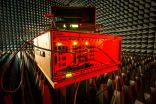(Press-News.org) A multidisciplinary team led by Johns Hopkins researcher Venu Raman, Ph.D., with notable contributions from Guus Bol, Farhad Vesuna and Phuoc Tran of Johns Hopkins, has identified a new therapy for lung cancer, the most common cancer worldwide. The therapy has been in development for six years and involves a first-in-class molecule designed by the team. The molecule, RK-33, interrupts the cell cycle of lung cancer cells without harming normal cells, and it is effective both on its own and in combination with radiation therapy.
The team designed the molecule to bind to DDX3, an enzyme that normally helps in RNA unwinding and translating RNA into proteins. In addition, the team identified that DDX3 is involved in DNA repair. Normal cells have many such enzymes, but some cancers, including over 90 percent of the lung cancer samples studied by the team, overexpress DDX3. Binding DDX3 with RK-33 reduces the amount of DDX3 available, thus causing the cancer cells to die and making radiation therapy -- which damages DNA -- more effective.
"We can lower the dose of radiation significantly but actually get more bang for your buck" by pretreating lung cancer with RK-33, says Raman, an associate professor of radiology and radiological science, of oncology and a member of the Johns Hopkins Kimmel Cancer Center.
Published in the May issue of EMBO Molecular Medicine, the team's study primarily focuses on lung cancer, yet further studies with RK-33 are ongoing in multiple cancer types, including breast cancer, prostate, sarcoma and colorectal cancer.
"DDX3 is an extremely novel target associated with many cancer types," says Raman, "and perturbing its function with a small molecule will enhance efficacy for cancer treatment."
The team identified DDX3 while studying the effects of cigarette smoke on normal breast cells by looking for changes in gene expression. Given his training in developmental biology, Raman focused the team to seek a novel drug target on genes important to the development of model organisms -- fruit flies (Drosophila) and yeast (Saccharomyces cerevisiae) -- rather than on oncogenes that transform a normal cell into a cancer cell.
Unlike most biomarkers for cancer, DDX3 mRNA expression only increased slightly in the exposed breast cells, but the corresponding proteins levels were significantly higher. "We were pleasantly surprised by this finding," Raman says, "because it's not just finding a biomarker that matters. The key part is finding a biomarker that is druggable."
To test DDX3's druggability, the team chose to design its own small molecule rather than screen libraries of molecules already created. "If you find something that appears to work, you have the ability to modify the parent compound to generate more potent molecules," says Raman.
It took many attempts before the team hit upon RK-33. "It is a lot of intelligent planning and hard work, but we have to get lucky too," says Raman, "because the risk of it not working -- using rational drug design -- is reasonably high."
"It is hard to find a magic bullet for cancer treatment," says Raman, "but because RK-33 is nontoxic and is a phenomenal radiosensitizer, there are so many opportunities." Patents in the U.S. and in several international markets already have been awarded both for the composition of RK-33 and for the use of RK-33 as a radiosensitizer. Raman says the next big steps are in overcoming the technical challenges of delivering the drug, and completing the experiments essential to file for an Investigational New Drug Application with the Food and Drug Administration to start clinical trials.
INFORMATION:
Guus Bol, Farhad Vesuna, Min Xie, Jing Zeng, Khaled Aziz, Nishant Gandhi, Anne Levine, Ashley Irving, Dorian Korz, Saritha Tantravedi, Marise Heerma van Voss, Kathleen Gabrielson, Leslie Cope, Michelle Rudek, Paul van Diest and Phuoc Tran of Johns Hopkins Medicine contributed to the research. Evan Bordt, Brian Polster, Atul Kondaskar and Ramachandra Hosmane of the University of Maryland, and Petra van der Croep and Elsken van der Wall of the University Medical Center Utrecht also contributed to the research work.
The work was supported by the Dr. Saal van Swanenberg Foundation, the Dutch Cancer Society, the Department of Defense's Cancer Physician Research Training Award and Idea Award, the American Chemical Society Scholar award, the Maryland Innovation Initiative Award and the Analytical Pharmacology Core of the Johns Hopkins Kimmel Cancer Center, with grants from the National Institutes of Health.
Media contacts:
Marin Hedin, (410) 502-9429, mhedin2@jhmi.edu,
Helen Jones, (410) 502-9422, hjones49@jhmi.edu
LAWRENCE -- Whole Foods Market encourages its employees to connect with the supermarket's "core values" on a personal level and make them "come to life" every day in their work.
Whether it's at the organic foods supermarket or firms such as Google or Apple or even Southwest Airlines, cohesive corporate culture is a strong buzzword among some of the world's most successful companies.
However, a University of Kansas researcher who studies the intersection of economics, evolutionary theory and philosophy has found that strong culture among a business' employees is only ...
The drug dasabuvir (trade name Exviera) has been available since January 2015 for the treatment of adults with chronic hepatitis C infection. The German Institute for Quality and Efficiency in Health Care (IQWiG) examined in a dossier assessment whether this drug offers an added benefit over the appropriate comparator therapy.
According to the findings, there are indications of an added benefit in patients who have not yet developed cirrhosis of the liver and who are infected with the hepatitis C virus (HCV) genotype 1a. In case of genotype 1b, this only applies to treatment-naive, ...
Radio systems, such as mobile phones and wireless internet connections, have become an integral part of modern life. However, today's devices use twice as much of the radio spectrum as is necessary. New technology is being developed that could fundamentally change radio design and could increase data rates and network capacity, reduce power consumption, create cheaper devices and enable global roaming.
A pioneering team of researchers from the University of Bristol's Communication Systems and Networks research group, have developed a new technique that can estimate ...
Oral care products containing a natural chemical that stops bacteria harming teeth could help prevent decay, a study suggests.
The plant natural product acts against harmful mouth bacteria and could improve oral health by helping to prevent the build-up of plaque, researchers say.
The compound - known as trans-chalcone - is related to chemicals found in liquorice root. The study shows that it blocks the action of a key enzyme that allows the bacteria to thrive in oral cavities.
The bacteria - Streptococcus mutans - metabolise sugars from food and drink, which produces ...
Some mountain gorilla females linger into adulthood in the group into which they were born. In the process, they also remain in the company of their father, who is often their group's dominant male. To curb inbreeding, though, they appear to tactically avoid mating with their fathers. This strategy works so well that the chances of alpha gorilla males siring the offspring of their own daughters are effectively zero, according to Linda Vigilant of the Max Planck Institute for Anthropology in Germany. The findings are published in Springer's journal Behavioral Ecology and ...
CAMBRIDGE, Mass--Researchers have found a way to couple the properties of different two-dimensional materials to provide an exceptional degree of control over light waves. They say this has the potential to lead to new kinds of light detection, thermal-management systems, and high-resolution imaging devices.
The new findings -- using a layer of one-atom-thick graphene deposited on top of a similar 2-D layer of a material called hexagonal boron nitride (hBN) -- are published in the journal Nano Letters. The work is co-authored by MIT associate professor of mechanical engineering ...
The rapid evolution of gadgets has brought us an impressive array of "smart" products from phones to tablets, and now watches and glasses. But they still haven't broken free from their rigid form. Now scientists are reporting in the journal ACS Applied Materials & Interfaces a new step toward bendable electronics. They have developed the first light-emitting, transparent and flexible paper out of environmentally friendly materials via a simple, suction-filtration method.
Technology experts have long predicted the coming age of flexible electronics, and researchers have ...
Scientists from General Atomics and the U.S. Department of Energy's (DOE) Princeton Plasma Physics Laboratory (PPPL) have discovered a phenomenon that helps them to improve fusion plasmas, a finding that may quicken the development of fusion energy. Together with a team of researchers from across the United States, the scientists found that when they injected tiny grains of lithium into a plasma undergoing a particular kind of turbulence then, under the right conditions, the temperature and pressure rose dramatically. High heat and pressure are crucial to fusion, a process ...
(PARIS, FRANCE) - Clearing blood clots from arteries during treatment for an acute myocardial infarction was a relatively common practice until a recent, large-scale study showed that the technique, known as thrombectomy, might actually increase the risk of stroke. Now, new insights from the TOTAL trial, presented here at EuroPCR 2015, indicate that the risk of stroke with thrombectomy during angioplasty, compared to angioplasty alone is evident very early following the procedure.
Dr. Sanjit Jolly, the study's lead author and an interventional cardiologist and Associate ...
This beautiful planetary nebula is named after a dreadful creature from Greek mythology -- the Gorgon Medusa. It is also known as Sharpless 2-274 and is located in the constellation of [Gemini] (The Twins). The Medusa Nebula spans approximately four light-years and lies at a distance of about 1500 light-years. Despite its size it is extremely dim and hard to observe.
Medusa was a hideous creature with snakes in place of hair. These snakes are represented by the serpentine filaments of glowing gas in this nebula. The red glow from hydrogen and the fainter green emission ...



